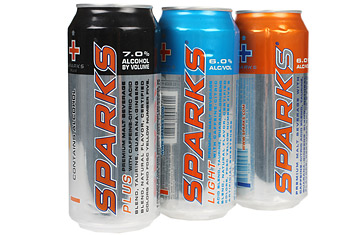
If you've never heard of alcoholic energy drinks, you're almost certainly over 25. Sold in tall, narrow cans, they carry teen-friendly names such as Sparks, Tilt and Joose. Like other flavored malt beverages — Mike's Hard Lemonade, for one, or Champale ("the malt liquor you serve like champagne") from back in the '60s — alcoholic energy drinks contain a lot of sugar and flavoring. The difference is that this new generation of malt beverages also contains stimulants. A typical can has about as much caffeine as a venti cup of Starbucks, along with additives like guarana and ginseng that can rev the central nervous system.
That's what has public-health and law-enforcement officials worried. Though flavored malt beverages make up less than 2% of alcohol servings in the U.S., alcohol-policy experts have long worried that many of those servings are consumed by minors who have no palate (yet) for real beer. The new alcoholic energy drinks have a further pull on the youth market: the promise that you can get drunk but still party all night because of the caffeine. Quite drunk: Joose, for instance, has the color and approximate flavor of strawberry soda, but it's 9% alcohol, compared with 5% for a typical can of Budweiser.
Law-enforcement officials want tighter regulations on the drinks. Maryland Attorney General Douglas Gansler, a Democrat who is helping lead a national campaign against the beverages, calls them "disgusting." He elaborated: "The caffeine is a stimulant that triggers the false impression that kids can drink more and still function normally. The kids won't recognize they are actually drunk...And then all of a sudden, over a short period of time, it goes Bam, and they're gone."
Mixing alcohol, a depressant, with stimulants is nothing new. The Irish have their eponymous coffee, and any authentic Italian restaurant offers something called caffè corretto, a shot of espresso mixed with a shot of grappa or sambuca. (The wonderfully knowing name translates as "corrected coffee.") But alcoholic energy drinks are different because they are so obviously marketed to kids. Ads are found mainly online or in publications like Blender. The Sparks website looks like it was designed by a (very young, very Flash-savvy) student.
Last year such concerns prompted Gansler and the attorneys general from 26 other states to write to Anheuser-Busch complaining about a particular alcoholic energy drink called Spykes. That drink, which was sold in such risibly juvenile flavors as Hot Mango, Spicy Melons and Hot Chocolate, was clearly aimed at girls. (The small Spykes bottle could fit easily into a pocketbook.) Anheuser-Busch responded by removing Spykes from the market — although the industry says alcoholic energy drinks are not intended for those under 21 and that any marketing designed to appeal to legal drinkers in their early 20s has to look youthful.
The marketing aside, alcoholic energy drinks raise a scientific question that many drinkers have long wondered about: can you counteract the effects of alcohol by drinking caffeine with it? Should you?
Researchers have conducted several peer-reviewed studies into these questions since 2000. The conclusions? Caffeine won't keep you from getting drunk. In fact, drinking caffeine with alcohol could be more dangerous than drinking alcohol alone, from a psychological perspective. One of the fascinating things about how humans process alcohol is that we involve our brains as well as our bodies: we have at least some capacity to overcome alcohol's effects by sheer force of will. Mark Fillmore, a psychologist at the University of Kentucky, has found that study volunteers who are warned that a certain alcoholic drink will highly impair their performance on a psychomotor test actually do better on the test than people who are given the same drink but no information about impairment. In other words, at least in a lab setting, those who are led to believe that they're about to get truly blotto end up not letting themselves get so blotto. They don't perform as well on their tests as sober people, but they perform a lot better than the average drinker.
Fillmore's research implies that mixing stimulants in alcoholic beverages might send a dangerous message: don't worry, the stimulants will protect you. In a 2002 Journal of Studies on Alcohol paper, Fillmore and his colleagues demonstrated this point: people who expected caffeine in their drinks to do the compensating work for them performed significantly worse on the same kinds of psychomotor tests than a group told that the caffeine would have no effect. The latter group, it seemed, had enlisted their own compensating mechanisms.
Alcohol functions in your body pretty much the same, whether you mix it with caffeine or not: you will be impaired. The problem is, you may not feel as impaired if caffeine is present. A 2006 study published in the journal Alcoholism: Clinical and Experimental Research found that people who drank energy drinks with alcohol felt better than those who drank only alcohol — the former group had significantly less dry mouth and headache. They also perceived their motor coordination to be better, even though it wasn't.
Alcoholic energy drinks aren't just a crime against taste — worse, they trick your brain into believing you're not as drunk as you are. Bottom line: have a real beer instead. If your beverage of choice carries a silly name like Tilt, you're probably too young to drink anyway.
